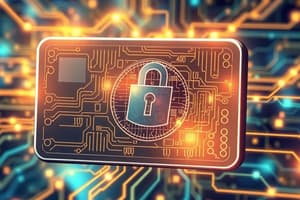Podcast
Questions and Answers
What was the purpose of the Clipper chip designed by the U.S. government in 1993?
What was the purpose of the Clipper chip designed by the U.S. government in 1993?
- To enable the government to decrypt any encrypted traffic (correct)
- To create a more secure form of RAM
- To enhance the speed of data encryption
- To allow users to encrypt data securely
In the context of smartcards, what is stored in the EEPROM?
In the context of smartcards, what is stored in the EEPROM?
- The Law Enforcement Access Field (LEAF)
- The ciphertext
- Key material (correct)
- The user-supplied key
What problem do EEPROM-based devices face when erasing information?
What problem do EEPROM-based devices face when erasing information?
- High voltage requirement for erasure (correct)
- Low sensitivity to voltage changes
- Inability to store volatile information
- Quick depletion of stored data
How did attackers manipulate early smartcards in pay-TV systems?
How did attackers manipulate early smartcards in pay-TV systems?
Which operation does Capstone include along with public key encryption and digital signatures?
Which operation does Capstone include along with public key encryption and digital signatures?
What key information does Clipper return along with the ciphertext when encrypting data?
What key information does Clipper return along with the ciphertext when encrypting data?
What role does the Law Enforcement Access Field (LEAF) play in Clipper's encryption process?
What role does the Law Enforcement Access Field (LEAF) play in Clipper's encryption process?
Why is it a concern if an attacker can remove the charge stored in EEPROM memory cells?
Why is it a concern if an attacker can remove the charge stored in EEPROM memory cells?
How did attackers prevent certain channels from being deactivated in pay-TV systems?
How did attackers prevent certain channels from being deactivated in pay-TV systems?
What was a common way that subscribers manipulated their smartcards in pay-TV systems to prevent deactivation of channels they didn't pay for?
What was a common way that subscribers manipulated their smartcards in pay-TV systems to prevent deactivation of channels they didn't pay for?




